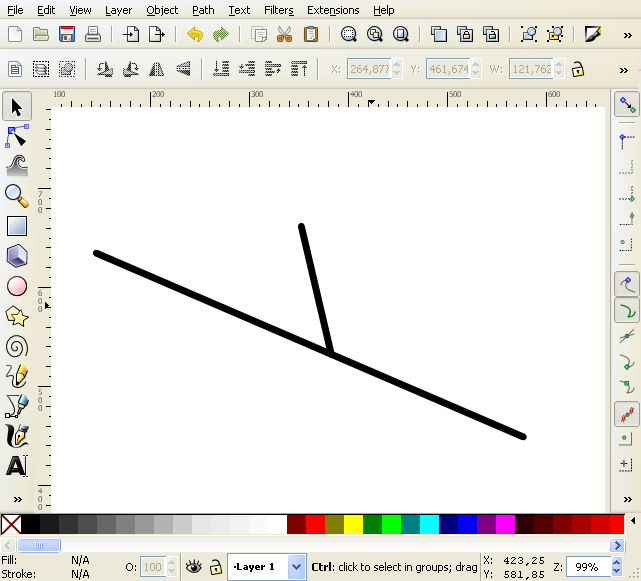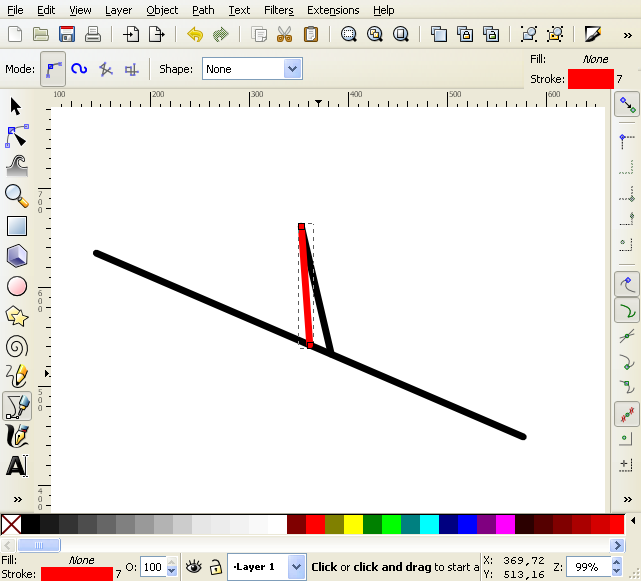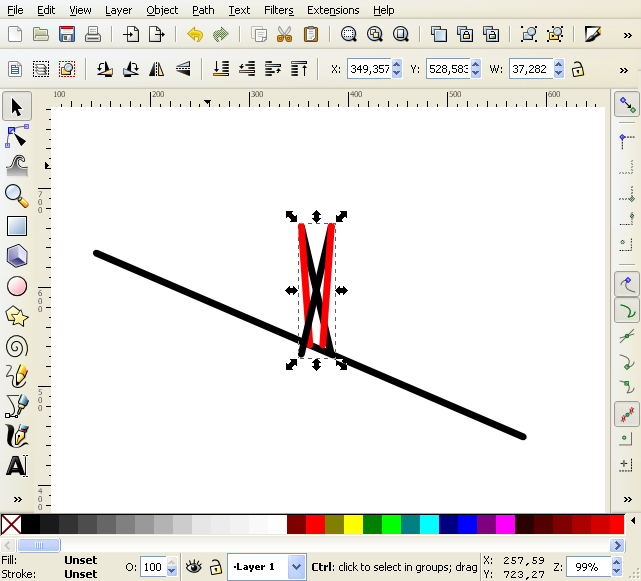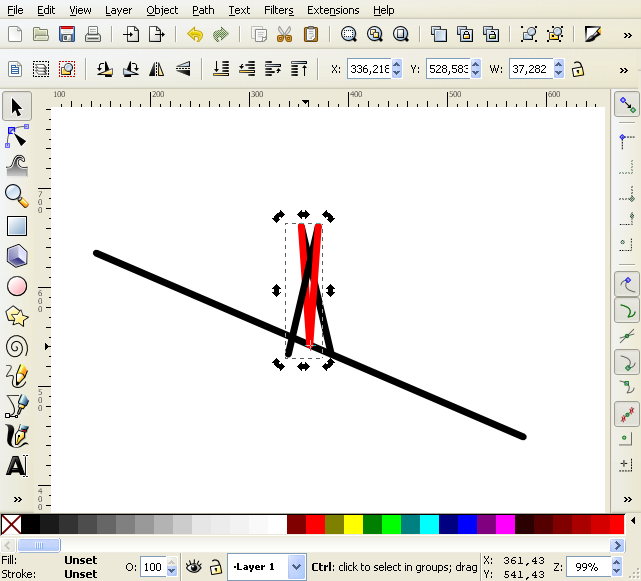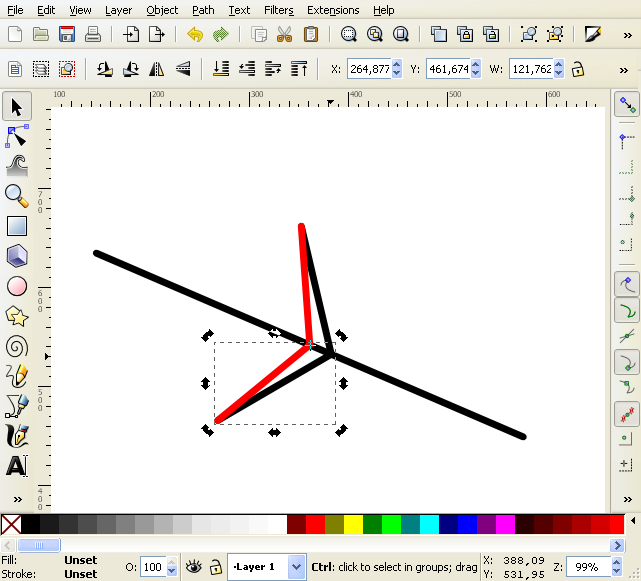I found myself needing to do the very same thing this week, I resorted to hacking some python (a first for me), I thought I would share the results!
Pretty simple, to use, duplicate your object, shift-select your axis for reflection and then pick the mirror extension.
mirror.pyCode: Select all
#!/usr/bin/env python
"""
Derived from the "envelope" extension by Aaron Spike, aaron@ekips.org
This program is free software; you can redistribute it and/or modify
it under the terms of the GNU General Public License as published by
the Free Software Foundation; either version 2 of the License, or
(at your option) any later version.
This program is distributed in the hope that it will be useful,
but WITHOUT ANY WARRANTY; without even the implied warranty of
MERCHANTABILITY or FITNESS FOR A PARTICULAR PURPOSE. See the
GNU General Public License for more details.
You should have received a copy of the GNU General Public License
along with this program; if not, write to the Free Software
Foundation, Inc., 59 Temple Place, Suite 330, Boston, MA 02111-1307 USA
"""
import inkex, os, simplepath, cubicsuperpath
from ffgeom import *
import gettext
_ = gettext.gettext
try:
from subprocess import Popen, PIPE
bsubprocess = True
except:
bsubprocess = False
class Project(inkex.Effect):
def __init__(self):
inkex.Effect.__init__(self)
def effect(self):
if len(self.options.ids) < 2:
inkex.errormsg(_("This extension requires two selected paths. \nThe second path must be exactly two nodes long."))
exit()
#obj is selected second
obj = self.selected[self.options.ids[0]]
trafo = self.selected[self.options.ids[1]]
if obj.get(inkex.addNS('type','sodipodi')):
inkex.errormsg(_("The first selected object is of type '%s'.\nTry using the procedure Path->Object to Path." % obj.get(inkex.addNS('type','sodipodi'))))
exit()
if obj.tag == inkex.addNS('path','svg') or obj.tag == inkex.addNS('g','svg'):
if trafo.tag == inkex.addNS('path','svg'):
#distil trafo into two node points
trafo = cubicsuperpath.parsePath(trafo.get('d'))
if len(trafo[0]) < 2:
inkex.errormsg(_("This extension requires that the second selected path be two nodes long."))
exit()
trafo = [[Point(csp[1][0],csp[1][1]) for csp in subs] for subs in trafo][0][:2]
#START HERE!!!
self.orig = [trafo[0]['x'], trafo[0]['y']]
self.vect = vect_dif([trafo[1]['x'], trafo[1]['y']], self.orig)
self.norm = vect_norm(self.vect)
self.unit = [self.vect[0]/self.norm, self.vect[1]/self.norm]
if obj.tag == inkex.addNS("path",'svg'):
self.process_path(obj)
if obj.tag == inkex.addNS("g",'svg'):
self.process_group(obj)
else:
if trafo.tag == inkex.addNS('g','svg'):
inkex.errormsg(_("The second selected object is a group, not a path.\nTry using the procedure Object->Ungroup."))
else:
inkex.errormsg(_("The second selected object is not a path.\nTry using the procedure Path->Object to Path."))
exit()
else:
inkex.errormsg(_("The first selected object is not a path.\nTry using the procedure Path->Object to Path."))
exit()
def process_group(self,group):
for node in group:
if node.tag == inkex.addNS('path','svg'):
self.process_path(node)
if node.tag == inkex.addNS('g','svg'):
self.process_group(node)
def process_path(self,path):
d = path.get('d')
p = cubicsuperpath.parsePath(d)
for subs in p:
for csp in subs:
csp[0] = self.trafopoint(csp[0])
csp[1] = self.trafopoint(csp[1])
csp[2] = self.trafopoint(csp[2])
path.set('d',cubicsuperpath.formatPath(p))
def trafopoint(self,(x,y)):
# x1' = -x1 + 2xo + 2n^[(x1 - xo).n^]
return vect_sub(vect_add(vect_mul(self.orig, 2), vect_mul(self.unit, 2 * dot_prod(vect_sub([x, y], self.orig), self.unit))), [x, y])
def vect_dif((x1, y1), (x2, y2)):
return [x2-x1, y2-y1]
def sum_sq((x, y)):
return x**2 + y**2
def vect_norm((x,y)):
return sum_sq([x, y])**.5
def vect_add((x1, y1), (x2, y2)):
return [x1+x2, y1+y2]
def vect_sub((x1, y1), (x2, y2)):
return [x1-x2, y1-y2]
def vect_mul((x, y), s):
return [x*s, y*s]
def dot_prod((x1, y1), (x2, y2)):
return (x1 * x2) + (y1 * y2)
if __name__ == '__main__':
e = Project()
e.affect()
# vim: expandtab shiftwidth=4 tabstop=8 softtabstop=4 encoding=utf-8 textwidth=99
Code: Select all
<?xml version="1.0" encoding="UTF-8"?>
<inkscape-extension xmlns="http://www.inkscape.org/namespace/inkscape/extension">
<_name>Mirror</_name>
<id>test.apex.mirror</id>
<dependency type="executable" location="extensions">mirror.py</dependency>
<dependency type="executable" location="extensions">inkex.py</dependency>
<effect>
<object-type>path</object-type>
<effects-menu>
<submenu _name="Modify Path"/>
</effects-menu>
</effect>
<script>
<command reldir="extensions" interpreter="python">mirror.py</command>
</script>
</inkscape-extension>I'm sure that python should have most of the vector ops that I cobbled together in its math library, but I didn't take time to look, I'm still a little surprised that I got it to work!
Thanks to Arron Spike for the envelope/prospective extensions that I butchered in order to make this one, and thanks to Wolfram.com for the math!
Happy mirroring!

 This is a read-only archive of the inkscapeforum.com site. You can search for info here or post new questions and comments at
This is a read-only archive of the inkscapeforum.com site. You can search for info here or post new questions and comments at 
